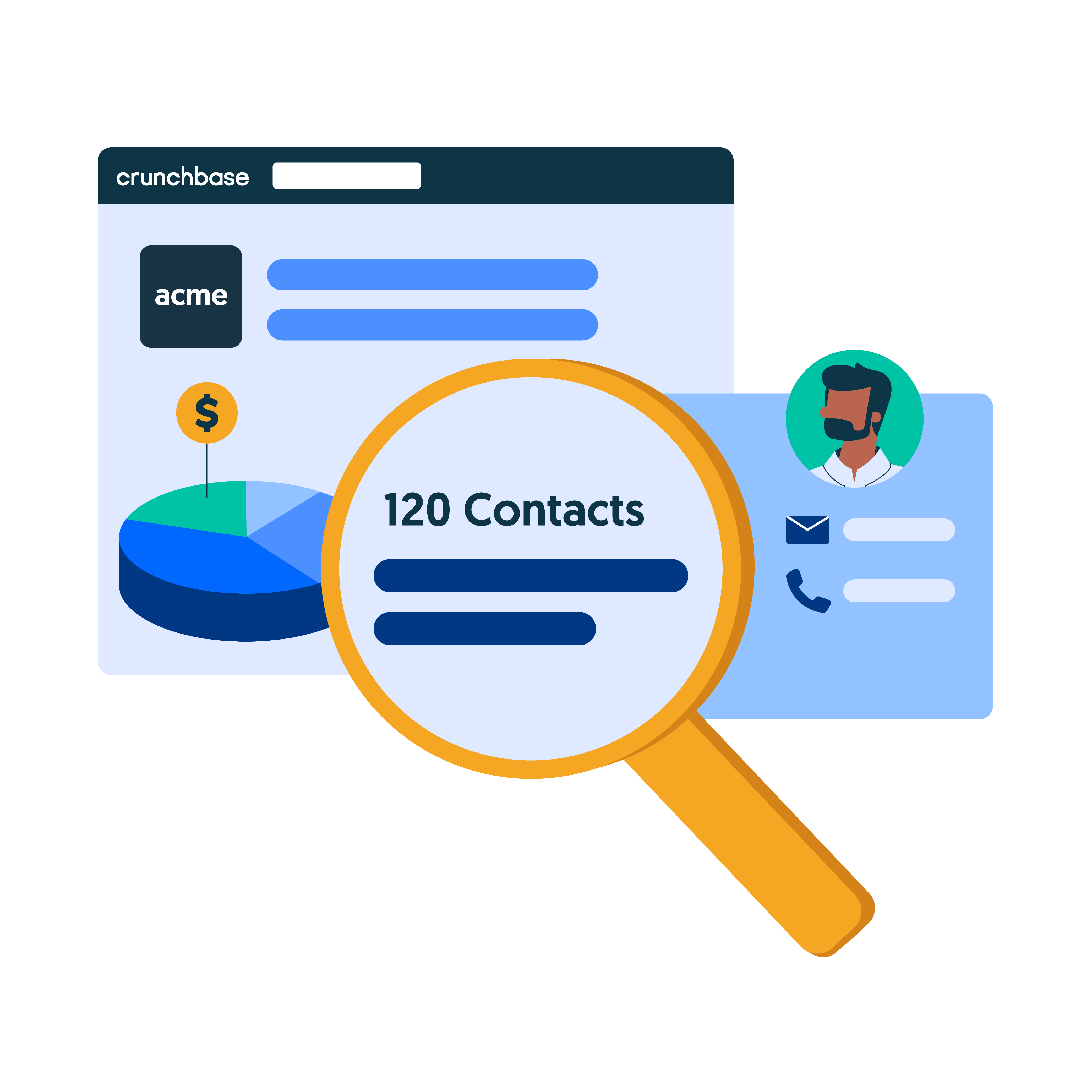Lead nurturing is widely recognized as a valuable marketing technique that can help teams drive an increase in sales. Implementing a successful lead-nurturing plan can significantly influence your marketing campaign’s outcomes, as well as customer loyalty, retention, revenue and more.
Search less. Close more.
Customize your outreach with Crunchbase, the all-in-one prospecting solution.
In this article, we’ll walk through the most successful lead-nurturing strategies to help you connect with prospects and close more deals.
- What is lead nurturing?
- Why is lead nurturing beneficial?
- Types of lead-nurturing campaigns
- Lead-nurturing strategies to boost sales
What is lead nurturing?
At every level of the sales funnel, whether it’s B2C or B2B, lead nurturing is the act of building and reinforcing connections with customers. A successful lead-nurturing funnel concentrates marketing and communication efforts on listening to prospects’ needs and presenting information in a way that establishes trust, raises brand recognition, and maintains relationships until prospects are ready to buy. That’s why developing a smart lead scoring system is critical for nurturing buyer connections. Additionally, the increasing length of the B2B sales funnel encourages prospect independence, necessitating well-designed lead-nurturing programs.
A successful lead-nurturing strategy will enable you to build relationships with potential customers and keep them engaged throughout the sales process. At the same time, the right strategy will allow prospects to progress through the buyer’s journey at their own speed. You’ll create enduring connections, boost click-through rates (CTRs), and enhance a lead’s propensity to buy by implementing a lead-nurturing program. Lead-nurturing campaigns not only build engagement with buyers but also allow you to use the data you acquire–like relevant buy signals–to evaluate their interest and track their behavior to improve future efforts and boost ROI.
With the emergence of buyers in the B2B sales cycle, it’s critical to provide buyers with a unified cross-channel experience. Consumers expect a level of personalization in marketing to capture their attention, but don’t want to be bombarded with advertisements or emails. Personalization and coordination in your sales and marketing outreach can help you cut through the noise and close more deals by providing information that’s truly relevant to your prospects.
That’s why effective lead nurturing must consider all of your sales and marketing tactics to ensure alignment in the messages your organization is sending. This includes:
- Newsletters
- Product updates
- Sales outreach sequences
- Database email alerts (new funding, buy signals, etc.)
Ensuring every touchpoint with a prospect is relevant and timely will help you facilitate a seamless transition from marketing to sales and help you close more deals.
Search less. Close more.
Track critical company buy signals with Crunchbase.
Why is lead nurturing beneficial?
Lead nurturing helps marketing teams create meaningful, long-term connections with prospects. When a visitor gives you their contact information by signing up for a newsletter, filling out a form on your site, etc., they’re consciously choosing to become a lead. Essentially, they’re signing up for nurturing and establishing a line of communication with your company.
Now, it’s your job to turn this opportunity into a sale by keeping your solution top of mind and delivering the right content at the right time. Here are just a few of the benefits a lead-nurturing strategy provides:
- Keeps your target audience informed.
Organizations with the right lead-nurturing strategy would never send out generic sales emails. This so-called “spray and pray” approach doesn’t engage your audience or provide any concrete information about how your solution can help solve a lead’s pain points. Lead nurturing is the process of identifying the needs of your audience and appropriately customizing content to different subgroups of that audience. The most effective lead-nurturing campaigns will engage your target audience in a personalized and timely manner, and drive engagement.
- Prepares the groundwork for sales.
Even the most effective marketing may be for naught if it does not result in sales. That said, your marketing should not be designed to pressure anyone into making a purchase decision; instead, your goal should be to cultivate an informed and engaged audience of new prospects. When prospects develop a trusting connection with you, there’s a good chance they’ll come to you when they’re ready to buy. That’s why it’s so important to establish a lead nurturing campaign that clearly articulates who you are and the value of your solutions.
- Helps identify prospects’ pain points.
Lead nurturing provides your audiences a clear path to follow as you gradually educate them about the solutions your company has to offer. And, a lead’s actions and clicks can help you better understand what information leads are looking for and help you craft tailored content that addresses specific pain points.
- Drives brand awareness.
Every nurturing campaign presents an opportunity to keep your brand top of mind and drive an increase in awareness. Marketing teams that prioritize and understand the value of lead nurturing will reap the rewards of a pipeline full of opportunities (and a very happy sales team).
Types of lead nurturing campaigns
Lead nurturing campaigns are foundational for strategizing content for your prospects’ sales funnels, assuring sales and conversion. Marketers can build distinct buyer personas to interact with prospects individually, therefore boosting company conversions by testing both B2C and B2B lead nurturing campaigns. Here are a few B2B lead-nurturing email examples to keep in mind when developing your marketing strategy:
- Educational: Educational campaigns are excellent for prospects who aren’t quite ready to buy. The goal of this type of campaign is simply to inform prospects of the solution(s) you provide and, if you’re lucky, garner their interest.
- Engagement: Engagement campaigns focus on driving interactions before and after prospects register for an event (such as a webinar, conference, etc.).
- Product/Service: Product/service campaigns focus on the specific features a prospect has demonstrated a desire to learn more about.
- Authority: Prospects often seek third-party validation when making purchase decisions. Pointing your prospects to relevant review sites like G2 and TrustRadius, sharing relevant customer stories, and highlighting current customers can help you demonstrate your authority and drive sales.
- Re-engagement: This lead-nurturing strategy functions as a wake-up call for leads who may have fallen silent during the sales cycle.
- Promotional: Promotional campaigns, such as discounts and special pricing, create a sense of urgency and can drive quick sales wins.
- Welcome: Welcome emails guide new customers through the onboarding process. Ensure your welcome emails are helpful, concise and actionable; the better your customers can navigate and understand your product or service, the more likely they are to stick around.
Lead-nurturing strategies to boost your sales
While there are many different lead-nurturing techniques out there, here are a few methods you can begin incorporating into your marketing strategy now:
- Develop targeted content.
There’s no such thing as a one-size-fits-all approach to lead nurturing. Carefully nurturing your leads with relevant content can increase sales substantially. Begin by getting to know each of your distinct buyer personas. Then, depending on their interests, goals, ambitions and marketing triggers, focus on producing tailored content. Marketing automation technology can also help you discover, segment and target distinct buyer personas.
- Implement multichannel lead-nurturing strategies.
With so many new communication channels, many marketers are on the lookout for innovative strategies that go beyond email nurturing. Marketers are increasingly using multichannel lead nurturing campaigns, often with the help of sophisticated marketing automation systems. Typical components of effective multichannel lead nurturing include:
- Social media
- Sponsored retargeting
- Dynamic website content
- Direct sales outreach
Given the number of strategies involved, you’ll need to make sure your sales and marketing teams are aligned and working together to effectively execute this approach and ensure you’re not overwhelming prospects with communication on too many channels.
- Learn from prospect engagement.
While every buyer’s journey is unique, on average, prospects receive 10 marketing touchpoints before they become clients. Evaluating how your prospects interact with different campaigns and tracking which efforts lead to sales can help you refine your content and overall strategy.
- Follow up with leads as soon as possible.
Although automated lead nurturing can help you contact huge groups of prospects, the best method to turn incoming leads into qualified sales opportunities is simply sending a timely follow-up email or making a phone call. According to research by Harvard Business Review, firms that follow up within an hour of receiving an inquiry are “nearly seven times more likely to qualify a lead.”
Skip the cold calls. Make real connections.
Leverage Crunchbase sales intelligence to personalize your outreach and close more deals.
- Personalize your campaign emails.
Email marketing continues to endure as a highly successful lead-nurturing B2B strategy, and personalizing the content in your emails significantly increases your odds of driving conversion. There are a variety of ways to personalize emails to boost your lead-nurturing approach. When a prospect downloads product-specific materials, clicks on links in an email campaign, or accesses specific pages on your website, you may want these actions to send triggered emails. The combination of marketing customization and behaviorally triggered emails can help you send the right messages at the right time.
- Establish lead scoring techniques.
Lead scoring is a way of ranking prospects by value according to criteria established by your company. You can incorporate lead scoring by assigning numeric values to specific website browsing habits, conversion events, or even social media interactions. The resulting lead score can help your team decide which leads your sales team should follow up with immediately, and which leads require further nurturing.
- Ensure alignment between sales and marketing tactics.
When sales and marketing teams work in unison, lead-nurturing methods are more successful and client retention rates rise. Consider different triggers like lead scoring and conversion events to determine the exact points in the buyer’s journey when you should transfer prospects across teams. Both sales and marketing should participate in developing a lead-nurturing strategy and work together to drive conversion.
Close more deals with Crunchbase
With Crunchbase’s all-in-one prospecting solution you can discover qualified accounts that match your ideal customer profile, monitor company buy signals, and connect with decision-makers, all in one place.
Want to learn more? Check out the Crunchbase blog for tips on how to connect with relevant contacts, find investors for a startup, and more.






